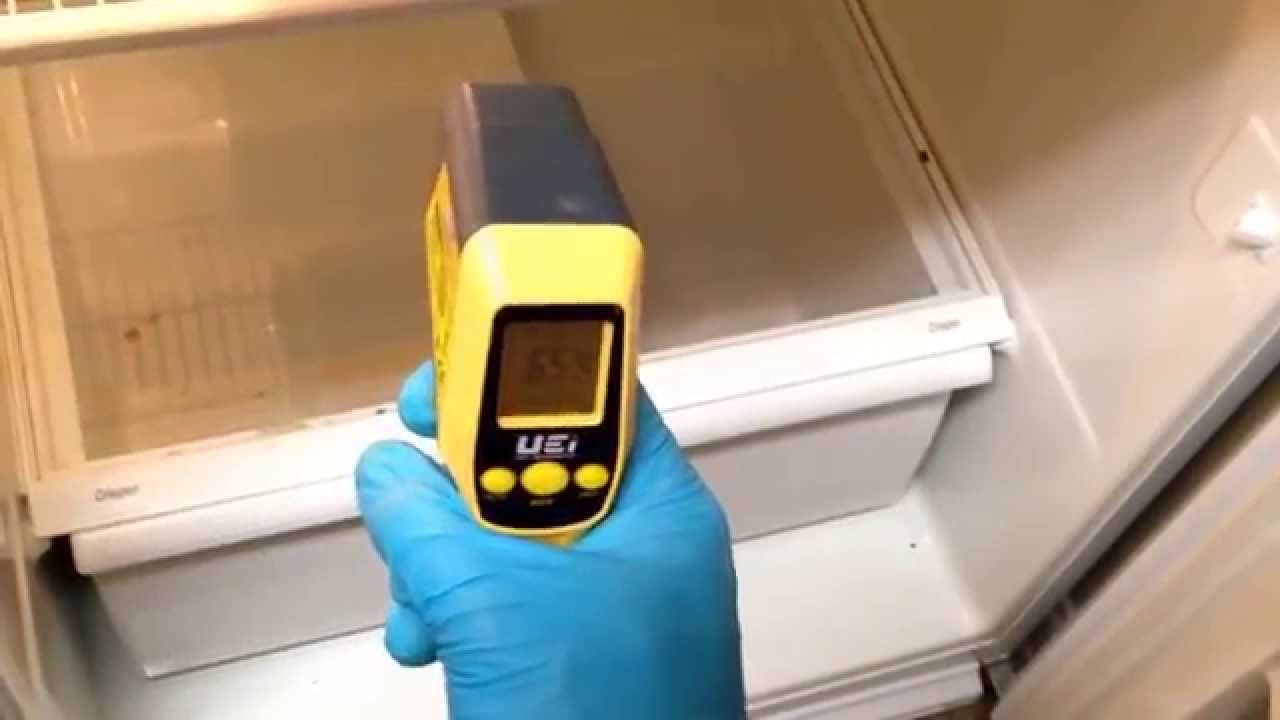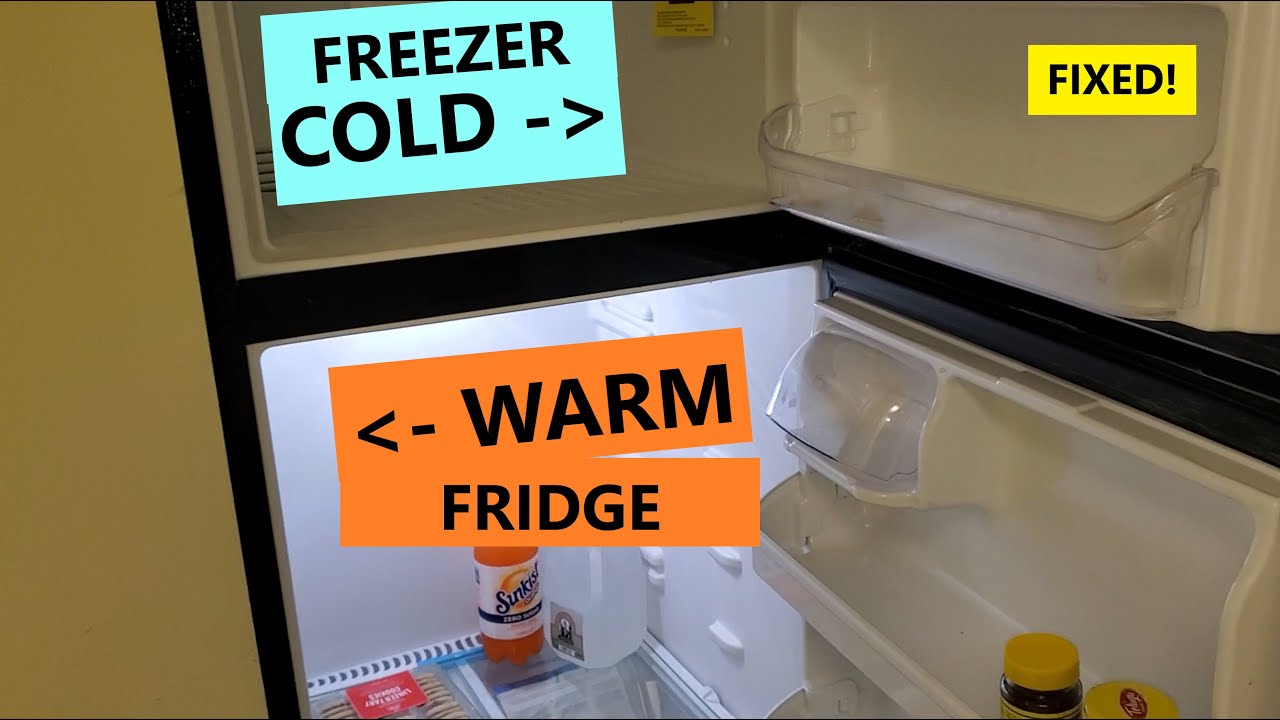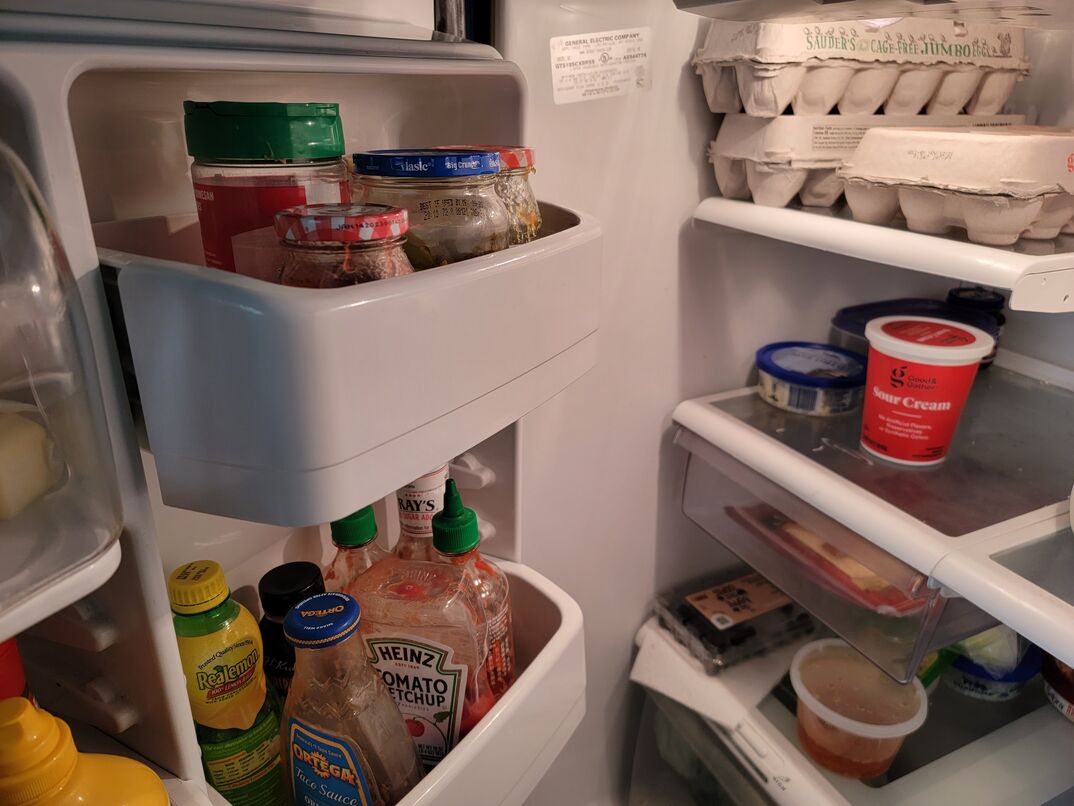Is yourrefrigerator too warm, leaving you with spoiled food and drinks? This can be a frustrating and even costly problem to deal with. A refrigerator that fails to cool properly can be caused by a variety of issues, ranging from a dirty condenser coil to a faulty compressor.
It can also be confusing when the freezer remains cold but the refrigerator compartment is warm. Let's explore some of the common causes of a refrigerator too warm, as well as some DIY solutions to help you troubleshoot and fix the problem.
What Causes A Refrigerator To Stop Cooling Or Get Warm?
A refrigerator is an essential household appliance that keeps our food fresh and prevents it from spoiling. However, sometimes it can stop working correctly, and we notice that it is no longer cooling or has become warm. Several factors can cause this problem, including:
- Dirty Condenser Coils- Condenser coils are responsible for removing heat from the refrigerator. Over time, they can accumulate dust and debris, which can block the flow of air and cause the refrigerator to stop cooling. To fix this problem, you can clean the coils using a vacuum cleaner or a brush.
- Faulty Evaporator Fan- The evaporator fan is responsible for circulating cool air throughout the refrigerator. If it stops working, the refrigerator may become warm. This problem can be caused by a faulty fan motor or a blockage in the fan blades. To fix this problem, you may need to replace the fan motor or remove any obstruction from the blades.
- Malfunctioning Thermostat - The thermostat regulates the temperature inside the refrigerator. If it is faulty, it may not signal the compressor to turn on or off, causing the refrigerator to stop cooling or become too warm. To fix this problem, you may need to replace the thermostat.
- Damaged Door Gasket- The door gasket is a rubber seal that keeps the cold air inside the refrigerator. If it is damaged or worn out, it can allow warm air to enter the refrigerator, causing it to become warm. To fix this problem, you may need to replace the door gasket.
- Defective Compressor- The compressor is responsible for compressing the refrigerant and circulating it through the refrigeration system. If it is defective, it may not be able to circulate the refrigerant, causing the refrigerator to stop cooling. To fix this problem, you may need to replace the compressor.
- Low Refrigerant Levels - If the refrigerant levels are low, the refrigerator may not be able to cool properly. This problem can be caused by a leak in the refrigerant lines or a faulty compressor. To fix this problem, you may need to locate and repair the leak and recharge the refrigerant.
- Power Supply Issues- If the refrigerator is not receiving sufficient power, it may not be able to cool properly. This problem can be caused by a faulty outlet or a tripped circuit breaker. To fix this problem, you may need to check the power supply and reset the circuit breaker.
Several factors can cause a refrigerator to stop cooling or become warm. If you notice this problem, you should check for the above issues and try to fix them. If you are unable to fix the problem, you may need to call a professional technician to diagnose and repair the refrigerator.
Why Is The Freezer Cold But The Refrigerator Is Warm?
If your freezer is cold but the refrigerator is warm, it can be a frustrating and confusing problem. There are several reasons why this can happen, including:
- Blocked Air Vents- The air vents between the freezer and refrigeator sections allow cold air to circulate throughout the appliance. If they are blocked by food or ice, the refrigerator may not receive enough cold air, causing it to become warm. To fix this problem, you can remove any obstruction from the vents using a soft brush or a hairdryer.
- Damaged Door Gasket - As mentioned earlier, the door gasket keeps the cold air inside the refrigerator. If it is damaged or worn out, warm air can enter the refrigerator, causing it to become warm. However, it may not affect the freezer, which is a closed compartment. To fix this problem, you may need to replace the door gasket.
- Faulty Evaporator Fan- The evaporator fan circulates cool air throughout the refrigerator. If it stops working, the refrigerator may become warm. However, the freezer can still stay cold because it has its own fan. To fix this problem, you may need to replace the fan motor or remove any obstruction from the blades.
- Low Refrigerant Levels- If the refrigerant levels are low, the refrigerator may not be able to cool properly. This problem can be caused by a leak in the refrigerant lines or a faulty compressor. However, the freezer may still be able to maintain its temperature because it is a closed system. To fix this problem, you may need to locate and repair the leak and recharge the refrigerant.
- Defective Thermostat - If the thermostat is not working properly, it may not signal the compressor to turn on or off, causing the refrigerator to stop cooling or become too warm. However, the freezer may still maintain its temperature because it has its own thermostat. To fix this problem, you may need to replace the thermostat.
- Faulty Damper Control- The damper control is responsible for regulating the flow of cold air from the freezer to the refrigerator. If it is not working properly, the refrigerator may not receive enough cold air, causing it to become warm. However, the freezer may still maintain its temperature because it does not rely on the damper control. To fix this problem, you may need to replace the damper control.
So, if your freezer is cold but your refrigerator is warm, there are several potential causes. By checking the above issues, you can try to diagnose and fix the problem. If you are unable to fix the issue, you may need to call a professional technician to diagnose and repair the appliance.

Fridge is Warm but Freezer is Cold? DIY Repair
What Are Some DIY Fixes For A Warm Refrigerator?
If your refrigerator has stopped cooling or has become warm, there are some DIY fixes you can try before calling a professional technician. Here are some tips to help you troubleshoot and fix the problem:
- Clean the Condenser Coils- As mentioned earlier, the condenser coils can become dirty and block the flow of air, causing the refrigerator to stop cooling. You can clean the coils using a vacuum cleaner or a brush. Make sure to unplug the refrigerator before cleaning the coils.
- Check the Door Gasket - The door gasket keeps the cold air inside the refrigerator. If it is damaged or worn out, warm air can enter the refrigerator, causing it to become warm. You can check the door gasket by placing a dollar bill between the door and the gasket and closing the door. If you can pull the bill out easily, the gasket may need to be replaced.
- Check the Evaporator Fan- The evaporator fan circulates cool air throughout the refrigerator. If it stops working, the refrigerator may become warm. You can check the fan by removing the rear panel inside the freezer and checking the fan blades for any obstruction. You can also try spinning the fan blades by hand to see if they move freely. If the fan is not working, you may need to replace the fan motor.
- Check the Thermostat- The thermostat regulates the temperature inside the refrigerator. If it is faulty, it may not signal the compressor to turn on or off, causing the refrigerator to stop cooling or become too warm. You can check the thermostat by turning the temperature control to the highest setting and listening for a clicking sound. If you do not hear a clicking sound, the thermostat may need to be replaced.
- Check the Damper Control- The damper control regulates the flow of cold air from the freezer to the refrigerator. If it is not working properly, the refrigerator may not receive enough cold air, causing it to become warm. You can check the damper control by locating it and inspecting it for any damage or obstructions. You can also try adjusting the control to see if it makes a difference in the temperature inside the refrigerator. If the damper control is not working, you may need to replace it.
- Check the Condenser Fan- The condenser fan helps to cool the condenser coils. If it is not working, the coils may become too hot, causing the refrigerator to stop cooling. You can check the fan by locating it near the compressor and checking the blades for any obstructions or damage. You can also try spinning the blades by hand to see if they move freely. If the fan is not working, you may need to replace the fan motor.
- Defrost the Freezer- If the freezer is frosted over, it can block the airflow to the refrigerator, causing it to become warm. You can defrost the freezer by unplugging the refrigerator and leaving the freezer door open. You can also use a hairdryer to speed up the process. Once the ice has melted, plug the refrigerator back in and see if the problem has been resolved.
- Check the Refrigerant Levels- If the refrigerant levels are low, the refrigerator may not be able to cool properly. This problem can be caused by a leak in the refrigerant lines or a faulty compressor. You can check the refrigerant levels by using a refrigerant gauge. If the levels are low, you may need to locate and repair the leak and recharge the refrigerant.
These are some of the DIY fixes you can try if your refrigerator has stopped cooling or has become warm. However, if you are unsure about any of these fixes or if they do not solve the problem, it is best to call a professional technician to diagnose and repair the appliance.
My Fridge Isn't Working, But My Freezer Is. What's Going On?
If your refrigerator is not working, but your freezer is, it is likely due to one of the following reasons:
- Damaged or Worn Out Door Gasket- The door gasket keeps the cold air inside the refrigerator. If it is damaged or worn out, warm air can enter the refrigerator, causing it to become warm. However, the freezer may still be able to maintain its temperature because it has its own door gasket. You can check the door gasket by placing a dollar bill between the door and the gasket and closing the door. If you can pull the bill out easily, the gasket may need to be replaced.
- Faulty Evaporator Fan- The evaporator fan circulates cool air throughout the refrigerator. If it stops working, the refrigerator may become warm. However, the freezer can still stay cold because it has its own fan. To fix this problem, you may need to replace the fan motor or remove any obstruction from the blades.
- Clogged Condenser Coils- The condenser coils can become dirty and block the flow of air, causing the refrigerator to stop cooling. However, the freezer may still be able to maintain its temperature because it has its own set of coils. You can clean the coils using a vacuum cleaner or a brush.
- Low Refrigerant Levels- If the refrigerant levels are low, the refrigerator may not be able to cool properly. However, the freezer may still be able to maintain its temperature because it is a closed system. To fix this problem, you may need to locate and repair the leak and recharge the refrigerant.
- Defective Thermostat- If the thermostat is not working properly, it may not signal the compressor to turn on or off, causing the refrigerator to stop cooling or become too warm. However, the freezer may still maintain its temperature because it has its own thermostat. You can test the thermostat by turning it to the highest setting and listening for a click. If you do not hear a click, the thermostat may need to be replaced.
- Broken Compressor- The compressor is responsible for compressing the refrigerant and circulating it through the coils. If it is broken, the refrigerator may not be able to cool properly. However, the freezer may still be able to maintain its temperature because it has its own set of coils. To fix this problem, you may need to replace the compressor.
- Damaged or Worn Out Start Relay- The start relay helps to start the compressor. If it is damaged or worn out, the compressor may not be able to start, causing the refrigerator to stop cooling. However, the freezer may still be able to maintain its temperature because it has its own set of coils. To fix this problem, you may need to replace the start relay.
- Faulty Temperature Control Board - The temperature control board regulates the temperature inside the refrigerator. If it is faulty, it may not signal the compressor or fans to turn on or off, causing the refrigerator to stop cooling. However, the freezer may still be able to maintain its temperature because it has its own set of controls. To fix this problem, you may need to replace the temperature control board.

Freezer ICE Cold but Fridge Warm | SOLVED | Frigidaire, Kenmore Refridgerator FIX
People Also Ask
Why Is My Refrigerator Running Constantly?
If your refrigerator is running constantly, it may be due to a dirty condenser coil, a faulty thermostat, or low refrigerant levels. A dirty condenser coil can cause the compressor to work harder to cool the refrigerator, while a faulty thermostat can cause the compressor to run continuously. Low refrigerant levels can also cause the compressor to work harder than necessary. It's best to consult a professional technician to diagnose and fix the issue.
How Often Should I Clean The Condenser Coil?
The condenser coil should be cleaned at least twice a year to ensure optimal cooling performance. However, if you have pets or live in a dusty environment, you may need to clean it more frequently. You can use a vacuum or a soft brush to remove the dust and debris from the coil.
How Can I Tell If My Refrigerator Has Low Refrigerant Levels?
Low refrigerant levels can cause the refrigerator to stop cooling properly. Some signs that your refrigerator may have low refrigerant levels include the compressor running continuously, frost buildup on the evaporator coil, and a hissing or bubbling sound coming from the refrigerator. If you suspect that your refrigerator has low refrigerant levels, it's best to call a professional technician to diagnose and fix the issue.
Conclusion
In conclusion, a refrigerator too warm can be due to a variety of reasons. Some of the common causes include a dirty condenser coil, a faulty thermostat, a broken compressor, or low refrigerant levels.
Similarly, if your freezer is cold but your refrigerator is warm, it can be due to a damaged door gasket, a faulty evaporator fan, or a clogged condenser coil, among others.
By following the DIY fixes mentioned above, you may be able to resolve these issues and restore your refrigerator to its proper working condition. However, if the problem persists, it is best to call a professional technician to diagnose and repair the appliance.
